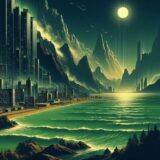
A collector asked me last year:
Watching Heritage and other auctions for the past couple of years, it seems that the artwork and books that are selling best and at the highest prices are those from the 30’s-60’s. I realize that a lot of it has to do with the scarcity of things from that period, but I’m wondering whether a lot of it also has to do with the fact that the majority of those buyers have familiarity and fondness for the artists/author/books from their adolescence, but in 20 years or so when a new generation of collectors comes along, they won’t have the same fondness/familiarity and therefore these same artists/authors won’t have the desirability they currently do. Do you have any thoughts about this?
My response:
As for what’s selling now, you raise an interesting point. There is a strong element of nostalgia in this (SF) collecting field, that motivates a certain % of collectors to buy what they buy. This is a motivator in many “collectibles” fields, from lunchboxes (Roy Rogers to Ninja Turtles) to costume jewelry to action figures….so it’s no surprise that it would affect comics, illustration art and books. HOWEVER – while this may account for the “‘first” wave of attraction – some number of buyers will continue beyond that initial appeal to develop connoiseurship….and from there, will migrate (or should I say, gravitate) to particular periods, sometimes far distant from where they began. In this way someone begins by buying The Hulk comic and then finds themself being pulled by some crazy attraction to He-man comics, and then the earliest super hero comics, and early Superman. Or starts with Crumb comics then satirical cartoons and then….Yellow Kid.
To be sure, this isn’t the story with MOST collectors, but then, MOST collectors of ANYTHING rarely get that serious. The real question is to what extent is nostalgia of this kind fueling the desirability (hence prices) of certain, shall we say, more topically popular artists today? It’s easy to get caught up in that sort of “bubble” – then, once that generation passes (as it did for Lone Ranger lunch boxes) the prices decline. There have been many such ‘bubbles’ in collecting fields, the obvious of them being ones like Beanie Babies. At the same time, however, Barbie dolls continue on….So this is something unpredictable.
This is where education comes in…which is the basis for a discriminating eye. But it is also why I counsel collectors not to put all their eggs in one basket. While it’s a pretty safe bet, at this point, that it will take more than a generation to make us forget the name Boris Vallejo – the fact that he’s painted hundreds of paintings, many of which look very much alike, is clearly not going to help collectors of today decide which one to buy. Indeed, and parodoxically, the problem is magnified for any artist whose success and wide popularity in the field can be linked to their strong, instantly recognizable highly individualistic style(s) of expression, like John Berkey Darrell K. Sweet, or even Michael Whelan. These are artists whose names won’t soon be forgotten. But 20 years from now…which sort of “Whelan” painting will collectors deem the ones that “made his reputation”? The Pern book covers for Anne McCaffrey or the massive fine art/visionary ones? Then there are other artists who are talented, innovative and have something to say, like John Jude Palencar. But will Americans ever come to love surrealism and dark imagery like the Europeans or will such art always take a back seat to more upbeat, “happier” painters like the Hildebrandts with their bright palettes and easy to digest dragons and wizards? There are real questions to be answered here…what are the art trends in mainstream culture, how will those affect the value of niche art genres, and who are the taste leaders there?
For at least a thousand years now we’ve been depicting angels and cherubim…and they are still popular today. But not as Michelangelo or even Titian envisioned them. Our tastes in angels, just as in nakid ladies, has changed since Goya. Roy Krenkel, known for his doodles of “fat girls,” was not respected for having been attracted to such female forms…but rather tolerated by collectors for having a mild obsession. So every collector has to have at least one “fat” Krenkel. For which he or she paid a third of what he’d pay for one of his dinosaurs (!) Had Roy doodled like Vargas, however, we would be viewing these little drawings differently today, you bet! And so it will go with Donato and other figurative painters whose style harkens back to Rembrandt. Will the next generations be as awed by “painterly” traditions of the Renaissance applied to images of Tolkien and mythology? This current love affair with realism and drawing ability…is its popularity being driven by nostalgic longing for the days when such skills mattered? Or will interest fade as such skills fade in importance to newer collectors, who – having no exposure to artists whose academic educations were a precursor to commercial commissions – don’t give a hoot whether artists can draw or not? Who knows?
All you can do is buy the art you want to look at while you’re living. And hope that maybe some part of the market will agree with your tastes when the time comes to sell. And if you die before you can test that, it will be someone else’s problem.
Jane











